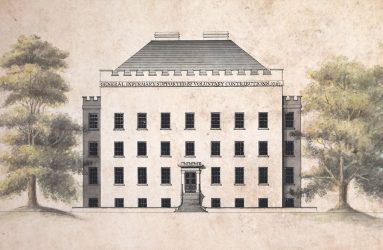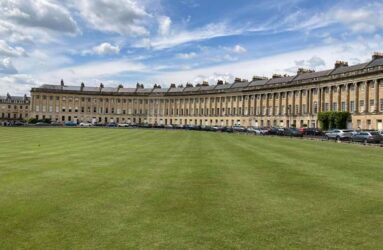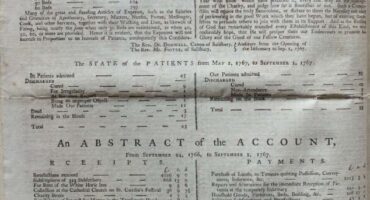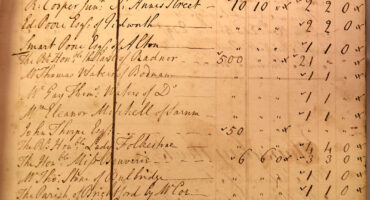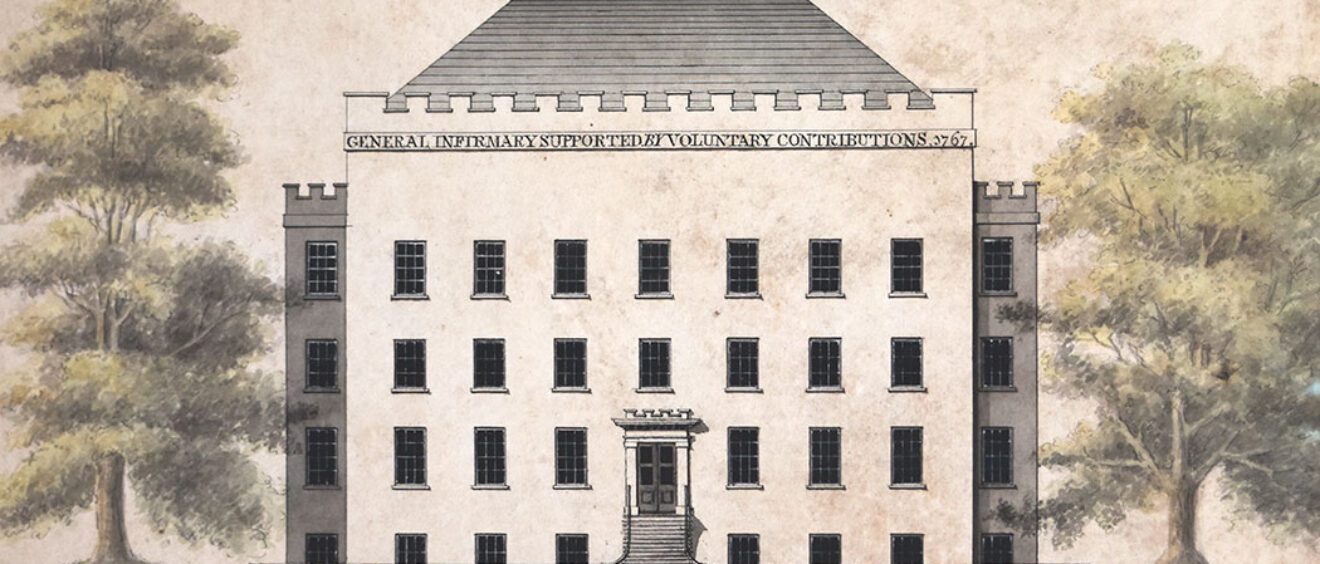
SGI 1767-1870: The beginning
Research by Stuart Wakefield
During the twelfth century, accommodation for lepers existed in Old Sarum. In 1245, a charter recorded that St Nicholas Hospital in Salisbury, on the north side of Harnham Bridge, was managed by lay brethren who cared for travellers needing to rest. In 1379, a private benefaction provided Trinity Hospital alms-houses for twelve permanent and eighteen temporary poor citizens. Whilst most institutions for treating the sick and wounded had been founded by the church, the eighteenth century witnessed a significant change to community medical care founded on philanthropic principles.
In 1765, the full funding requirement was realized, and the new building was finally complete and ready to accept patients in 1771. Its motto was taken from Psalm 9 “For the sick and needy shall not always be forgotten”
1767 Salisbury and Winchester Journal (SWJ) – 16 February; An advertisement for the supply of equipment “… all persons inclined to provide beds, bedding, curtains iron bedsteads etc. for the use of the said Infirmary …”.
Opening date announced!
1767 SWJ – 9 March; It was announced that the Infirmary “… will be opened for the reception of patients on Saturday the 2nd of May next …”. These were to be housed in cottages that existed on the periphery of the land purchased for the new building.
1767 SWJ – 16 March; The previous week’s announcement was repeated with a postscript added stating that “Subscribers and Benefactors may have the Statutes and Rules of the Infirmary, by applying, in person or under their own hands, to Mr. Collins, on the Canal”.
1767 SWJ – 23 March; That attention of Subscribers was drawn to the procedure for recommending patients from distant places which should be accompanied by “… a short state of the case, drawn up by some Physician, Surgeon or Apothecary, (post-paid), to which an answer shall be returned, whether and when they shall be admitted. But the Committee is at full liberty to reject such patients, if such cases appear to have been misrepresented, nor will any answer be sent to the letter whose postage or carriage is not paid …”. The format for the letter of recommendation followed.
Staff recruited
1767 SWJ – 6 April; Less than four weeks prior to the first patients being admitted, an advertisement was published for staff “Nurses and a Porter wanted for the said Infirmary. Persons of good character and well qualified may apply at the next meeting of the Committee …”.
1767 SWJ – 4 May; A Notice confirmed “… the said Infirmary was opened on Saturday last, and patients were admitted therein. Subscribers and Benefactors who have not paid their Subscriptions and Benefactions, arc requested forthwith to pay the same …”. Payment reminders became a regular issue raised by the Governors.
Building plans
1767 SWJ – 29 June; A Committee Meeting was called “… to fix on a plan for building the Infirmary …”. The Committee made substantial progress during its initial eight months, and at a meeting called to finalise the plan for the new Infirmary, John Wood, the Younger, (who was later to design Bath’s Royal Crescent), was appointed to provide a design for a four-storey 120 bed Infirmary. Within ten weeks the foundation stone was laid, after which the Earls of Pembroke and Radnor each donated a buck for the celebratory meal; (such gifts were customary when celebrating significant events).
1767 Annual Auditors’ Reports 1766 to 1851 (AR1) – The houses that had existed on the land purchased for the new Infirmary were demolished upon completion of the new building. The Report indicated that the price paid for the land was £1,013 [£128,318]. Meanwhile, £193 [£24,448] had been spent on the existing cottages during the interim to make them “… tolerably convenient …”. for patients.
Celebrations and processions
Each year, the Mayor and Corporation of Salisbury joined the Governors of the Infirmary in a procession from the Council Chamber to the Cathedral where Divine Service was held. In addition, patients who had been discharged from the Infirmary during the previous twelve months were invited to attend the ceremony Afterwards, the procession proceeded to the Infirmary where extracts from the Auditors’ Report were read out.
1768 SWJ – 19 September; After the annual procession, the Governors dined at the Half Moon. In subsequent years, the annual procession invariably concluded with an invitation to the Governors to attend an Ordinary (An Ordinary was described as a modest meal) at a variety of Salisbury inns, including the Three Lions in 1769, the White Hart Inn in 1804; the Cross Keys in 1807; the Spread Eagle Inn in 1808; the Antelope Inn in 1812, the Black Horse Inn in 1815 and the Sun Inn in 1820.
1768 SWJ – 25 January; The Committee initially planned to complete the Infirmary within two years, and advertised for “All bricklayers, masons, plasterers, tilers, plumbers, painters, glaziers and smiths willing to undertake their respective branches of work, in the intended Infirmary in Salisbury … to receive blank printed proposals, which they are to affix to their prices to sign, seal up, and deliver to the Committee …”. Three weeks later the newspaper carried an advertisement for “Any person willing to supply the Infirmary with 800,000 or any smaller number of bricks, of the full statutable measure, is desired forthwith to send his proposals, with the price … and to specify what quantity he will furnish every six months …N. B. The moulds will be provided by the Governors”
1769 AR1 – The Committee’s planned timescale was not achieved, as the Auditors regretted that a very wet start to the year had resulted in “… the great scarcity of bricks … it is however in great forwardness, and will, we are assured, be covered in this Autumn”. With reference to the temporary patient accommodation, the Auditors were pleased to confirm that “We have likewise the satisfaction … that no patient has hitherto been refused admittance for want of room”.
1770 AR1 – The following year, patients were still not being admitted to the new building, although a confident position was presented by the Auditors in stating that “The staircase being up provides easy access to the wards; and we trust the commodiousness of it will justify the Governors in what they have expended …”.
1771 AR1 – The Auditors were finally able to announce that “… we now congratulate the contributors to this charity on the new Infirmary being completely finished for the reception of patients”. The Auditors also found it fitting to defend themselves against criticism of the costs incurred in confidently predicting that “… objections will vanish when it is observed that the wards are more spacious and lofty than those in any other Infirmary in the Kingdom”. Whilst many of the charities that created Infirmaries during the eighteenth century were hoping that their design would be viewed as an expression of civic pride, Sir John Summerson, the architectural historian, wrote that “It cannot be said that any distinct architectural type for hospitals emerged … An exception is the younger John Wood’s Infirmary at Salisbury of 1767, a square mass with a central light well, a crenulate parapet and windows all of equal size and for ornament, an inscription in Roman Capitals”.
In 1842, more than seventy years after the first patients were admitted to the Infirmary, a Doctor wrote in the Visitors Book “I have, in the course of my life, carefully visited many hospitals, both in this country and others, but never met with the same appearance of comfort, cleanliness, and freedom from anything offensive to any of the senses, as in the Salisbury Infirmary”. Whilst the conditions in the Infirmary do not bear any resemblance to those considered to be acceptable today, this commendation, taken at face value, positions the Infirmary above many others of that time.

